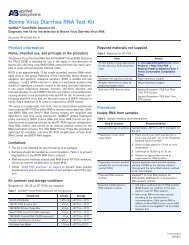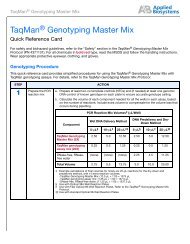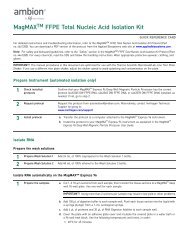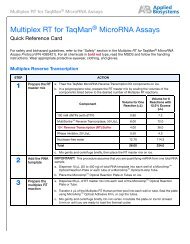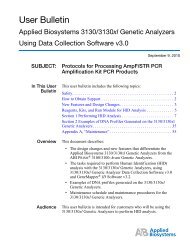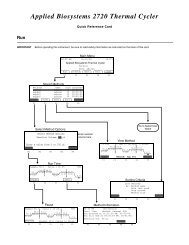AmpliTaq and AmpliTaq Gold DNA Polymerase - Applied Biosystems
AmpliTaq and AmpliTaq Gold DNA Polymerase - Applied Biosystems
AmpliTaq and AmpliTaq Gold DNA Polymerase - Applied Biosystems
You also want an ePaper? Increase the reach of your titles
YUMPU automatically turns print PDFs into web optimized ePapers that Google loves.
<strong>and</strong> MSP2 protein levels per A. marginale organism increase only minimally <strong>and</strong> transiently insalivary gl<strong>and</strong>s of transmission-feeding ticks compared to that of unfed ticks. A. marginalenumbers per tick increase gradually in salivary gl<strong>and</strong>s of both transmission-fed <strong>and</strong> unfed ticks. Itis concluded that MSP2 variant selection is an early event in the tick <strong>and</strong> that MSP2 variantsSGV1 <strong>and</strong> SGV2 are expressed both in the midgut <strong>and</strong> salivary gl<strong>and</strong>s. While MSP2 may berequired for infectivity, there is no strict temporal correlation between MSP2 expression <strong>and</strong> thedevelopment of infectivity.Mederle, I., I. Bourguin, et al. (2002). "Plasmidic versus Insertional Cloning of Heterologous Genes inMycobacterium bovis BCG: Impact on In Vivo Antigen Persistence <strong>and</strong> Immune Responses."Infect. Immun. 70(1): 303-314.http://iai.asm.org/cgi/content/abstract/70/1/303Bivalent recombinant strains of Mycobacterium bovis BCG (rBCG) expressing the early regulatorynef <strong>and</strong> the structural gag(p26) genes from the simian immunodeficiency virus (SIV) SIVmac251were engineered so that both genes were cotranscribed from a synthetic operon. The expressioncassette was cloned into a multicopy-replicating vector, <strong>and</strong> the expression levels of both nef <strong>and</strong>gag in the bivalent rBCG(nef-gag) strain were found to be comparable to those of monovalentrBCG(nef) or rBCG(gag) strains. However, extrachromosomal cloning of the nef-gag operon intoa replicative plasmid resulted in strains of low genetic stability that rapidly lost the plasmid in vivo.Thus, the nef-gag operon was inserted site specifically into the BCG chromosome by means ofmycobacteriophage Ms6-derived vectors. The resulting integrative rBCG(nef-gag) strains showedvery high genetic stability both in vitro <strong>and</strong> in vivo. The in vivo expression of the heterologousgenes was much longer lived when the expression cassette was inserted into the BCGchromosome. In one of the strains obtained, integrative cloning did not reduce the expressionlevels of the genes even though a single copy was present. Accordingly, this strain inducedcellular immune responses of the same magnitude as that of the replicative rBCG straincontaining several copies of the genes.Reglier-Poupet, H., E. Pellegrini, et al. (2003). "Identification of LpeA, a PsaA-Like Membrane ProteinThat Promotes Cell Entry by Listeria monocytogenes." Infect. Immun. 71(1): 474-482.http://iai.asm.org/cgi/content/abstract/71/1/474The intracellular life of Listeria monocytogenes starts by a complex process of entry involvingseveral bacterial lig<strong>and</strong>s <strong>and</strong> eukaryotic receptors. In this work, we identified in silico from thesequence of the genome of L. monocytogenes a previously unknown gene designated lpeA (forlipoprotein promoting entry) encoding a 35-kDa protein homologous to PsaA, a lipoproteinbelonging to the LraI family <strong>and</strong> implicated in the cell adherence of Streptococcus pneumoniae<strong>and</strong> related species. By constructing a mutant of L. monocytogenes in which lpeA is deleted (lpeAmutant), we show that the PsaA-like protein LpeA is not involved in bacterial adherence but isrequired for entry of L. monocytogenes in eukaryotic cells. In contrast to wild-type bacteria,mutant bacteria failed to invade the epithelial Caco-2 <strong>and</strong> hepatocyte TIB73 cell lines, asconfirmed by confocal microscopy. The mutant bacteria rapidly penetrated in mouse bonemarrow-derived macrophages. Surprisingly, lpeA mutant bacteria survive better in macrophagesthan do wild-type bacteria. This was correlated with a weak exacerbation of virulence of the lpeAmutant in the mouse. LpeA is therefore a novel invasin favoring the entry of L. monocytogenesinto nonprofessional phagocytes but not its invasion of macrophages. This is the first report of alipoprotein promoting cell invasion of an intracellular pathogen.






